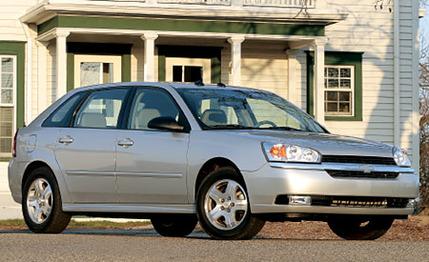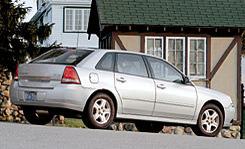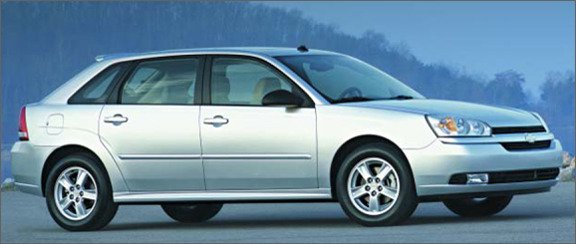
 Road Test
Road Test
In the past decade or so, Americans have embraced hatchbacks pretty much in the manner they have embraced ringworm and scabies. Chevrolet is keenly aware of this and prefers to call its new Malibu Maxx a "five-door extended sedan," bypassing the "hatch" and "wagon" identifiers entirely. That's a little like calling a Corvette a "downsized family coupe," but, hey, we can understand GM's nervousness. Of course, it makes you wonder why the General would want to style the Maxx's butt to resemble the stern end of Churchill's bulldog. The thing simply screams hatchback. How big a secret is this, really?
The Malibu sedan ( C/D, November 2003) and the Maxx both ride on GM's Epsilon platform, most familiar to Americans as the Saab 9-3 chassis. That explains the plastic clip in the left corner of the windshield. What, exactly, do the Swedes insert in those clips? Moose schematics?


The Maxx LT carries a base price of $24,725. In the mid-size-sedan class, that's a tall pile of clams, although the car is comprehensively equipped. Standard LT fare includes a 200-horse pushrod V-6, a four-speed automatic, anti-lock brakes, 16-inch alloys, a skylight above the rear seat, a CD player, leather seats, adjustable brake and accelerator pedals, a power driver's seat, and a remote starter capable of scaring the mustard out of slackers who happen to be leaning against your empty car. Options on our tester included a rear DVD/audio child-sedation system ($995), OnStar ($695), and XM satellite radio ($325). That nudged the total close to $27,000, navel-deep in V-6 Honda Accord and Toyota Camry territory. Which, for a car bearing the Malibu moniker, strikes us as the fiscal equivalent of poking a stick at the tiger that lunched on Roy.
But let's talk about the Maxx's hinder, which is what everyone notices first. Although this car is six inches longer in wheelbase than the sedan, it is a half-inch shorter in length. That's what you can do when you don't have to hang a trunk behind the rear wheels. The Maxx's hatch swings up to expose a cargo floor roughly 32 by 40 inches. It will accept 23 cubic feet of household miscellany--seven cubic feet beyond what the sedan's trunk can carry, five cubic feet less than what a Subaru Impreza wagon will hold. The aluminum liftgate is light, plus it features two handhold indents lined with a sandpaper-like material that offers astounding grip even in the rain. The cargo bay features a removable parcel shelf that can be fitted at three heights and can hold up to 200 pounds, in case you feel obliged to perform handstands back there. It can even be positioned to jut out of the open hatch, acting as a mini table for tailgate parties that don't exceed four six-packs.
But what truly distinguishes the Maxx is its Maximum Bob rear seats, which perform all manner of circus tricks. For starters, they're on tracks and can be adjusted through nearly seven inches of travel. Slide 'em fully astern, and you'll create 41 inches of legroom. It's like riding in a limo back there, almost too nice to waste on children. The rear seats recline, fold flat, and perform a 60/40 split. Very practical.
Climbing into the back seat is a breeze, too, because the door openings are four inches wider than the Malibu sedan's. Those on our staff who are still procreating report that baby-seat installation in this car is about 75 percent less likely to inflict back injuries. What's more, the front-passenger seatback folds flat so you can carry a nine-foot-long ladder and never expose its rungs to the elements. We flattened all the seats and managed to insert one full-size bicycle. It wasn't easy--some imaginative cursing was required--but it can be done.


The front-seat cushions are American-butt wide and lack lateral support but are otherwise comfortable. The steering wheel is adjustable for reach and rake, and the pedals are adjustable, too, so there's no trouble finding a perfect driving position. The headliner is a classy gray fabric, and the cabin's understated chrome accents show to nice effect. There's even a credible carbon-fiber motif on the gauge faces, whose white numerals make them easy to read. The Maxx's rotary HVAC controls are easy to understand, although the fan-speed control is so slow to react that it might be elected to Congress. What's more, if you turn the fan knob one tiny increment too far to port, it zings into automatic mode, where you have no control over it at all. Again like Congress.
The fixed skylight is useful for illuminating the rear seat and cargo area. Fact is, there's an airiness to the Maxx's cabin that reliably induces cheer and optimism.